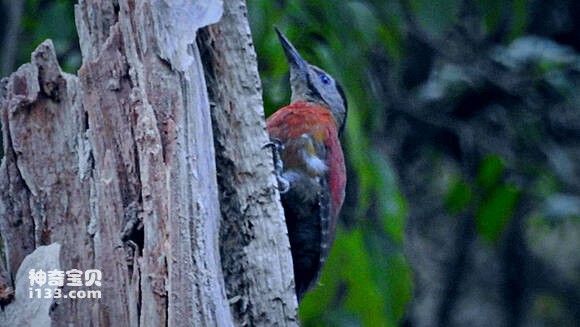Picus canus dedemi
IUCN
LCBasic Information
Scientific classification
- name:Picus canus dedemi
- Scientific Name:Picus canus dedemi,Picus dedemi,Sumatran woodpecker
- Outline:Climbing birds
- Family:
Vital signs
- length:26-33 cm
- Weight:No textual research information is available
- lifetime:No textual research information is available
Feature
Distribution and Habitat
It is found in the Sumatran highlands.
It mainly inhabits low mountain broad-leaved forests and mixed forests, but also occurs in secondary forests and forest margins, and rarely in primitive coniferous forests. Autumn and winter often appear on the roadside, farmland side of the open forest, but also often to the village near the small forest activities.
Appearance
Body length 26-33 cm. Male bird frontal base gray, mixed with black; Vermilion on the forehead and crown of the head; The back of the head, the pillow and the nape of the neck are grey or dull grey, with black plumage. The eyes are black, the brow lines are off-white. Ear feathers, neck side gray, zygomatic line black, wide and obvious. The back and wings are covered with olive green, the waist and tail are covered with greenish-yellow, the central tail feathers are olive-brown, two spots with gray white semicircular spots, the end is black, and the shaft is bright black; Lateral tail feathers dark brown, with dark stripes; The primary feathers are black, with white square stripes on the outside and white stripes on the inner base. The outer side of the secondary flight feathers is olive-yellow, and the white spots are not obvious. The chin, throat and foreneck of the lower body are grayish white, the thorax, abdomen and flanks are grayish green, the undertail covers are grayish green,
Details
苏门答腊绿啄木鸟学名Picus canus dedemi、Picus dedemi,外文名Sumatran woodpecker,直到最近,被认为是灰头绿啄木鸟的地域变种。

Sumatran green woodpeckers often live alone or in pairs. Rarely in groups. Autumn and winter often appear on the roadside, farmland by the open forest, but also often to the village near the small forest activities. Flying fast, flying in a wave. They often feed in the middle and lower part of the trunk, but also often feed on the ground, especially on the ground and the ant mound. It mainly feeds on ants, silverfish, longicorn larvae, lepidoptera, coleoptera, hymenoptera and other insects. Foraging often spirals up from the base of the trunk, then flies up to the base of another tree when it reaches the fork. Insects that can get under the bark or into the woody parts of tree trunks are hooked out with long tongues. They also occasionally eat plant fruits and seeds, such as mountain grapes, red pine seeds, yellow lily cones, and grass seeds.
Sumatran green woodpeckers breed from April to June. Nest in a hole in a tree. The nest hole is made by both male and female birds: a new nest hole is dug every year. Old nests are generally not used. Most of the nest holes are in mixed forest, broad-leaved forest, secondary forest or forest margin of manchu willow, aspen, thick plum, oak, elm and other wood decay trees. The nest hole is 7-11 meters high from the ground, the opening is round or oval, and there is no inner cushion in the nest. One brood a year, each brood lays 8-11 eggs, the eggs are milky white, smooth without spots, the shape is oval, incubation by male and female birds take turns, incubation period 12-13 days. Young birds are late sex, and male and female birds raise young together. After about 23-24 days of feeding, the chicks can fly and leave the nest.
Listed on the International Union for Conservation of Nature (IUCN) 2012 Red List of Threatened Species ver 3.1 - Low Risk (LC).
Protect wild animals and eliminate wild meat.
Maintaining ecological balance is everyone's responsibility!








